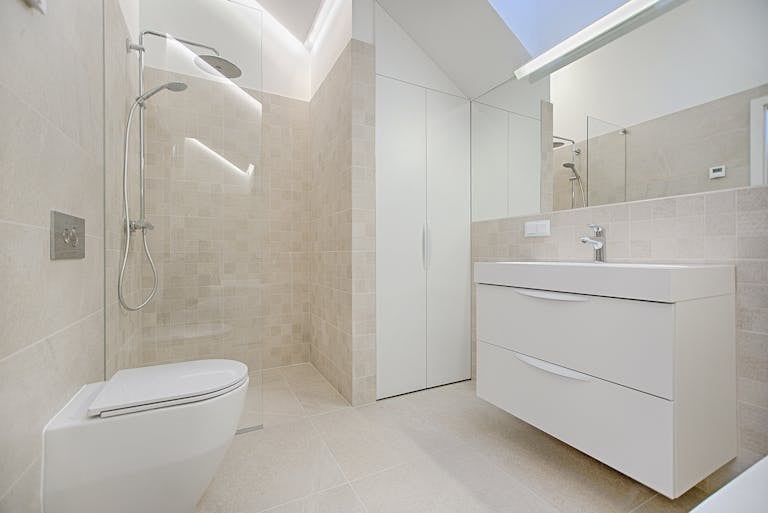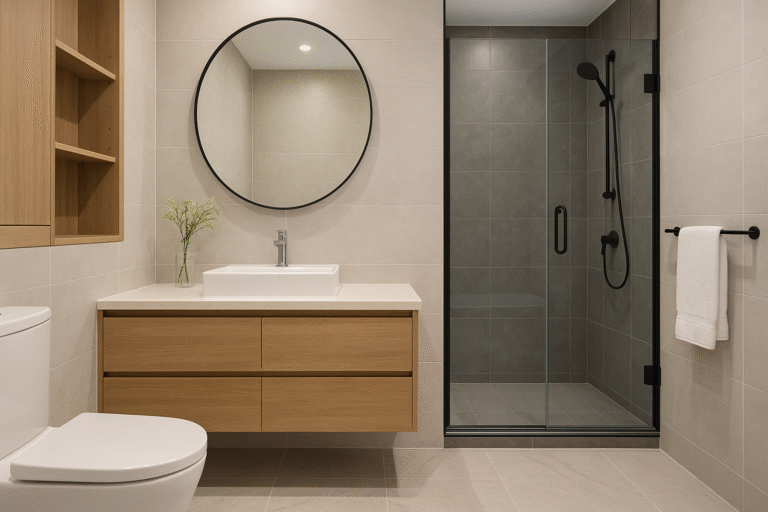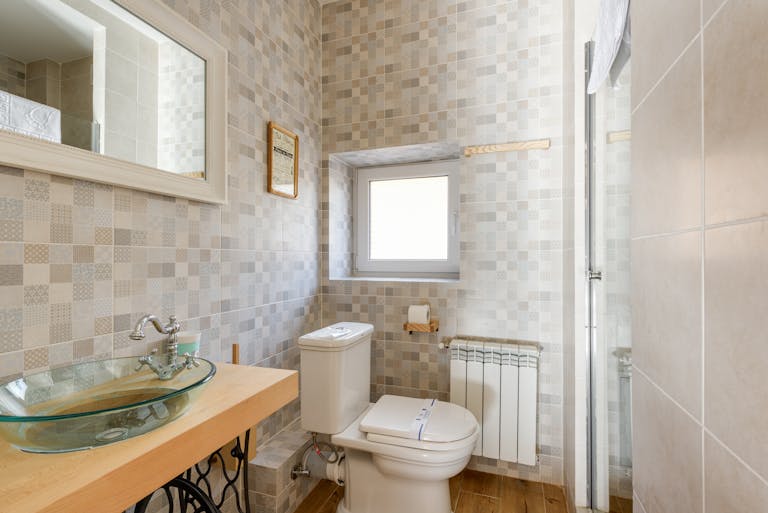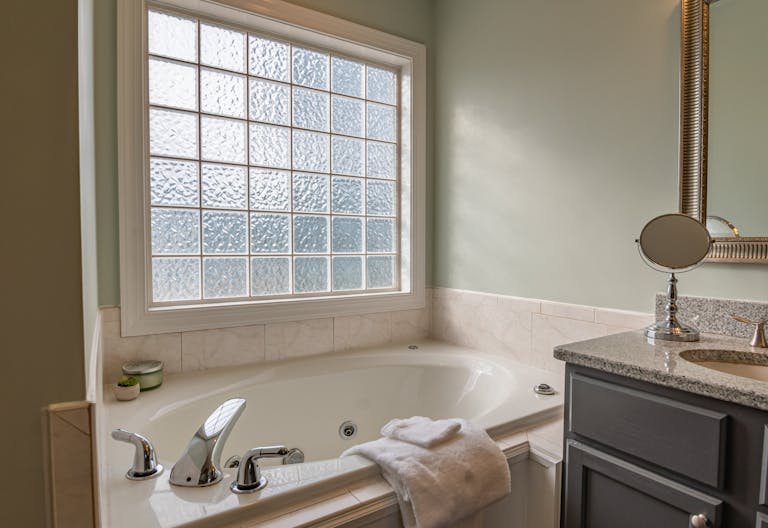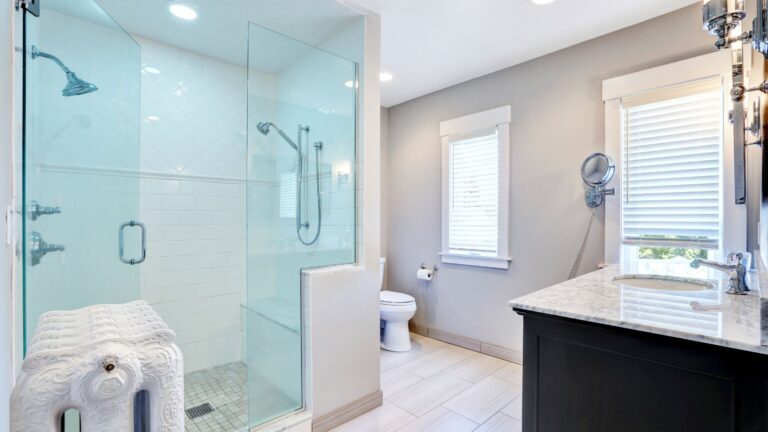Complete Homeowner’s Guide to Remodeling a Bathroom in 2025
A bathroom remodel is more than just a facelift. It’s an opportunity to reimagine one of the most used rooms in your home, blending practicality with personal style. Whether your goal is to modernize a dated space, fix ongoing issues, or increase your home’s value, a well-executed bathroom renovation delivers both comfort and a strong return on investment.
This all-in-one guide walks you through the entire remodeling process from beginning to end. We’ll cover how to prepare, plan your budget, avoid pitfalls, understand permits, work with professionals, and keep your remodel looking great for years to come.
If you’re looking for detailed articles on specific topics, we recommend reading our posts on the typical costs involved in a bathroom renovation, hiring a reliable remodeling contractor, or the newest bathroom styles and trends for 2025. If you’re ready to see the full picture, read on.
Early Planning: Laying the Foundation for a Smooth Remodel
Every great remodel starts with clarity. Before you think about colors or tiles, take time to define your priorities. Are you redesigning to boost your home’s resale appeal? Do you need more space for a growing family? Or are you upgrading for comfort and energy efficiency?
Once your goals are clear, consider how involved you want to be. While some homeowners love to get hands-on with design choices or even DIY small projects, others prefer to hand off most of the work to a skilled team. It’s important to be honest about your time, budget, and skill level before making that decision. If you’re unsure, our article on selecting the right bathroom renovation contractor outlines exactly what to look for in a professional partner.
Time is another factor that’s easy to overlook. Even modest remodels can take several weeks, and more involved projects could extend to two months or more. Be prepared for unexpected delays, especially when permits or custom products are involved.
A strong start also includes gathering ideas. Browse magazines, Pinterest boards, or local showrooms to clarify what you want and just as importantly, what you don’t want. Then list out everything you’d like to change or improve. This becomes your remodeling blueprint.
And finally, get a basic sense of what your dream bathroom might cost. You’ll find more detail in our budgeting tips for bathroom remodeling, but early awareness helps avoid sticker shock and prevents wasted time down the line.
Understanding Renovation Costs: What You’ll Likely Spend
Bathroom renovation budgets can vary widely depending on size, materials, and complexity. A cosmetic upgrade such as new fixtures, a fresh coat of paint, and modern lighting may cost far less than a full redesign that involves changing the layout, replacing plumbing lines, or upgrading finishes.
Generally, small bathrooms with modest upgrades may be completed for $8,000 to $12,000. Mid-tier remodels, where you replace vanities, tile, and fixtures but keep the layout intact, tend to fall in the $15,000 to $25,000 range. A top-tier transformation with premium materials and extensive custom work can start at $30,000 and go much higher.
A big part of your expenses will come from labor, not just materials. Hiring licensed plumbers, electricians, tile setters, and general contractors adds professional polish to your remodel but also adds to your budget. That said, skilled work pays off in reliability and resale value.
Homeowners are often surprised by hidden expenses. Things like mold behind drywall, outdated wiring, or off-square framing can increase costs during demolition. That’s why setting aside a 10 to 20 percent buffer for contingencies is always smart.
For an in-depth look at pricing, including material comparisons and labor breakdowns, visit our full bathroom renovation cost guide, which includes the most up-to-date averages for 2025.
Bathroom Renovation Permits and What to Know Before You Build
One of the biggest remodeling mistakes homeowners make is assuming permits are optional. In reality, most bathroom renovations, especially those involving plumbing, wiring, or structural work require official approval from your local building authority. Permits exist to ensure your project meets safety standards and building codes, which protects both you and future owners of your home.
Understanding when a permit is needed depends on the scope of your remodel. Cosmetic upgrades such as painting, replacing faucets, swapping out hardware, or installing a new mirror typically don’t require permits. However, the moment your project involves moving plumbing lines, updating electrical components, tearing down walls, or making any structural changes, you’ll need to apply for the proper authorizations.
Skipping the permit process may seem like a shortcut, but it often leads to costly problems. Unpermitted work can delay home sales, reduce appraisal values, or result in fines. In some cases, city inspectors may require you to undo or redo work that wasn’t inspected properly. For that reason, working with a contractor who understands the local permit process is extremely important. They can help prepare the necessary drawings, file the paperwork, and schedule inspections at key milestones.
The type of permits needed can vary from one municipality to another. In many cases, you’ll need at least a plumbing permit and an electrical permit, especially if you’re installing a new shower, relocating a toilet, or upgrading outlets to meet modern safety requirements. For major overhauls, a general building permit may also be necessary.
The permit process typically begins with submitting your renovation plans to your local building department. Once approved, you’ll be given documentation that must be posted at the job site. Inspections are then scheduled during construction usually after rough plumbing and wiring are complete, and again at project completion.
If your contractor brushes off the idea of permits or suggests skipping them, it’s a sign to reconsider who you’re working with. A responsible professional will never take shortcuts that could jeopardize your home or delay resale in the future.
If you’re unsure about the rules in your area, our complete guide on what bathroom remodeling permits you need offers deeper insight into permit types, application timelines, and tips for staying compliant throughout your renovation.
How to Find a Trusted Contractor for Your Remodel
Hiring the right contractor is one of the most important decisions you’ll make during your bathroom renovation. The skill, reliability, and professionalism of your contractor will directly affect your experience and the final result. A great contractor brings your vision to life, keeps the project on schedule, and helps you navigate the many decisions involved in a remodel. A poor one can lead to delays, budget overruns, and subpar workmanship.
Start your search by gathering referrals from people you trust. Friends, coworkers, or neighbors who have recently completed bathroom projects can often point you to reputable professionals. Online directories, reviews, and local building associations are also useful tools, but be sure to dig deeper than surface-level ratings. Look at photos of past work, ask for references, and confirm that the contractor is licensed and insured in your area.
Once you’ve narrowed down your list, set up interviews. A good contractor will be willing to meet, walk through the project, and provide a detailed quote. During these conversations, ask how they handle scheduling, what’s included in the contract, and how they manage subcontractors or unexpected changes. Trust your instincts, communication and transparency are just as important as technical skill.
Request written estimates from at least two or three contractors so you can compare pricing, timelines, and the level of detail provided. Watch out for unusually low bids, as they may signal inexperience or hidden costs. A thorough estimate should include material costs, labor, permit fees, and a projected start and end date.
Make sure everything you agree on is captured in a formal contract. That includes the scope of work, payment schedule, deadlines, and what happens if there are delays or changes. Never rely on verbal agreements, no matter how trustworthy someone may seem.
You’ll be working closely with this person or team for several weeks, so choose someone you feel comfortable communicating with. Check how they’ve handled past issues, how often they’ll be on-site, and who you should contact with questions during the build.
For a complete checklist of what to look for including sample questions to ask and warning signs to avoid check out our guide on how to choose a bathroom remodeling professional. It’s designed to help you feel confident as you make one of the most important decisions in your remodeling journey.
Emerging Bathroom Styles and Features in 2025
As design preferences continue to evolve, 2025 is shaping up to be a year where comfort, technology, and sustainability come together in modern bathroom renovations. Homeowners are seeking more than just updated aesthetics they want bathrooms that feel like personal sanctuaries, equipped with smart features and built to support wellness, energy savings, and effortless function.
Natural materials and spa-inspired touches are dominating bathroom style boards this year. Think light wood tones, stone textures, soft neutrals, and subtle patterns that evoke calm and simplicity. Organic design elements, like fluted wall panels or warm tile finishes, are being paired with clean lines to create a balance of modern and inviting. Floating vanities and frameless glass showers continue to trend, especially in bathrooms where maximizing space and light is a priority.
Smart technology is another defining theme in 2025 renovations. More homeowners are incorporating voice-activated lighting, programmable shower systems, heated floors with digital controls, and smart mirrors that display the time, weather, or even news headlines. These tech enhancements not only bring convenience but also personalize the experience, making the bathroom feel more like a luxury retreat than a utilitarian space.
Color trends are moving away from sterile all-white schemes in favor of rich, grounded hues. Deep greens, muted blues, and warm terracottas are making their way into tile backsplashes, cabinetry, and accent walls. These colors bring a sense of character and warmth, especially when paired with brass or matte black fixtures.
Sustainability remains a high priority. Water-efficient toilets, low-flow faucets, and LED lighting are no longer niche they’re becoming standard in remodels that aim to reduce environmental impact. Many homeowners are also choosing durable materials like porcelain or quartz that require less maintenance and have a longer life cycle.
In terms of layout, open-concept designs that reduce visual barriers are popular in both large and small bathrooms. Removing bulky tubs or unnecessary dividing walls can free up space and help the room feel bigger. Built-in shower niches, recessed lighting, and under-cabinet motion lighting are also being added to enhance usability without crowding the design.
Whether you’re aiming for subtle sophistication or bold contrast, this year’s trends offer a range of options that blend practicality with elevated style. For a closer look at what’s catching attention this year, read our article on 2025 bathroom design trends and style inspiration to find the perfect direction for your own space.
How to Protect Your Bathroom from Moisture and Mold
Water may be essential to a bathroom’s function, but it also poses one of the biggest risks to the longevity of your renovation. Without proper moisture control, even a freshly remodeled space can fall victim to mold, rot, and unseen structural damage. Knowing how to prevent water-related problems isn’t just smart it’s necessary if you want your investment to last.
Bathrooms are naturally high-humidity zones, and everyday activities like showering and bathing create an ideal environment for moisture buildup. If that moisture gets behind walls or under flooring, it can compromise materials and foster mold growth, which is both expensive to fix and potentially hazardous to your health.
To keep these issues at bay, prevention should begin during the construction phase. If you’re remodeling a shower area, make sure your contractor uses waterproof backer boards instead of standard drywall. Adding a waterproof membrane behind tile and sealing all joints with mold-resistant caulk is essential. Areas around tubs, sinks, and toilets should be reinforced with proper sealants to stop water from leaking into surrounding surfaces.
Ventilation plays a huge role in mold prevention. Every bathroom should have a vent fan that’s powerful enough for the room size. A good fan will pull humid air out of the space quickly, reducing the chance of moisture settling on walls or ceilings. Consider a model with a humidity sensor that activates automatically when moisture levels rise. This is especially helpful in households where fans are often forgotten.
Material selection also matters. Porcelain and ceramic tiles resist water more effectively than natural wood or untreated stone. If you love the look of wood, choose engineered wood or luxury vinyl planks designed specifically for wet spaces. Similarly, non-porous countertops like quartz or solid-surface materials are better choices for durability and ease of cleaning.
After the remodel is complete, regular maintenance is key to preventing problems. Reapply caulk as it ages, keep an eye out for dark spots on grout lines or ceilings, and wipe down wet surfaces regularly to prevent mildew. It’s also a good idea to inspect plumbing under the sink and behind the toilet every few months to catch leaks early.
If you’d like a deeper breakdown of how to build a moisture-proof space, our full resource on bathroom mold prevention and water damage control offers practical strategies you can apply before, during, and after your remodel. Protecting your bathroom from water problems ensures it stays fresh, clean, and trouble-free for years to come.
Smart Ways to Build and Manage Your Remodel Budget
Budgeting is where vision meets reality. You might have a clear idea of what you want your bathroom to look like, but aligning those ideas with actual costs is what brings the project to life and keeps it on track. Whether you’re planning a modest refresh or a high-end transformation, starting with a solid financial plan is critical to a smooth and stress-free renovation.
First, determine your spending limit based on your goals, not just what you think a remodel “should” cost. Are you updating the bathroom to sell your home? Then a mid-range renovation focused on broad appeal might be the smartest investment. If this is your forever home, you may want to invest in higher-end finishes or custom elements. Once your goals are clear, break your total budget into categories such as labor, materials, fixtures, design, permits, and an emergency buffer.
It’s essential to think in terms of line items. Instead of saying, “I’ll spend around $15,000,” list out expected costs for the vanity, flooring, lighting, tile, plumbing fixtures, and labor. This not only gives you more control but also helps you identify areas where you can scale back or upgrade. For example, you might choose a standard tub so you can spend more on elegant tile work or energy-efficient lighting.
One of the smartest financial decisions you can make is setting aside a contingency fund. During renovations, unexpected problems often arise hidden water damage, outdated wiring, or structural quirks that require adjustments. Having an additional ten to twenty percent of your budget set aside for surprises gives you flexibility and peace of mind.
If your remodeling budget feels tight, look for ways to save without compromising quality. Choosing ready-made vanities instead of custom cabinetry, using mid-range fixtures from trusted brands, or keeping your plumbing layout intact can significantly reduce costs. You may also be able to stretch your budget further by sourcing materials during seasonal sales or clearance events.
Another important piece of the puzzle is deciding how to finance your remodel. Some homeowners use savings, while others explore home equity loans, personal loans, or renovation-specific credit programs. If you go this route, make sure your repayment terms are manageable and that you’re not overextending yourself financially.
To help you organize every aspect of your spending, our detailed guide on planning a bathroom renovation budget offers templates, cost-saving tips, and real-world examples to help you budget with confidence. Having a clear plan allows you to prioritize wisely and avoid financial strain, so your remodel adds joy not stress to your life.
Designing for Small Bathrooms Without Compromise
A small bathroom doesn’t have to feel cramped or limited. In fact, many of the most elegant and efficient bathroom designs come from working within compact spaces. With the right layout, clever storage, and thoughtful styling, even the smallest bathrooms can feel open, modern, and highly functional.
The key is to think in terms of space optimization. Before making any design decisions, study how the current layout works and how it doesn’t. Could you swap out a traditional bathtub for a streamlined walk-in shower? Would a wall-mounted sink or floating vanity open up floor space? Often, rethinking the arrangement of fixtures is enough to dramatically improve both flow and usability.
Visual strategies also make a big impact. Light-colored walls, large-format tiles, and well-placed mirrors help create the illusion of space. Glossy surfaces reflect more light, which brightens the room and reduces any sense of confinement. Frameless glass shower enclosures are another smart addition because they eliminate visual barriers that can make a room feel divided.
Storage should be discreet and vertical. Instead of bulky cabinets that crowd the floor, opt for built-in shelving, recessed niches, or open floating shelves. Medicine cabinets with mirrored fronts serve a dual purpose and are especially helpful in tight quarters. Over-the-toilet storage units or tall, narrow cabinets can also help you maximize every inch without cluttering the space.
Lighting can make or break a small bathroom. Relying on a single ceiling fixture can cast unflattering shadows and highlight tight corners. A combination of task lighting at the vanity and ambient lighting in the ceiling or shower creates a more even glow. Adding under-cabinet or toe-kick lighting can enhance both visibility and ambiance.
Finally, don’t shy away from personality. Just because the space is small doesn’t mean it has to be boring. Accent walls with patterned tile, bold hardware finishes, or stylish pendant lights can add character without overwhelming the room. The goal is to find that sweet spot between efficiency and expression.
A small bathroom remodel may come with limitations, but it also offers the chance to make big improvements with smart design moves. With the right strategies, you can achieve a space that feels bigger, functions better, and looks just as polished as a larger bath.
What to Expect with High-End Bathroom Remodels
Luxury bathroom renovations go beyond basic upgrades. They’re about creating an elevated experience, a space that blends refined design with high-end performance. From spa-inspired features to personalized layouts, a premium remodel turns your bathroom into a private retreat that matches your lifestyle.
What sets upscale remodels apart is the level of customization and detail. These projects often start with a professional designer who helps you map out every inch of the space. Think heated flooring that warms your feet on cold mornings, a rainfall shower system with body jets, or a deep freestanding soaking tub set against a feature wall of textured tile or natural stone. Every choice in a luxury bathroom serves a dual purpose comfort and elegance.
Material selection is a major factor in luxury remodels. Homeowners may opt for marble countertops, artisan tile, or solid wood cabinetry built to last decades. Finishes like brushed gold, matte black, or custom hardware add personality and richness to the overall aesthetic. Even small details such as built-in towel warmers or soft-close drawers contribute to a sense of quiet sophistication.
Technology is also making its mark in premium bathroom designs. High-end renovations increasingly include digital shower controls, smart mirrors with built-in lighting and defogging, voice-controlled lighting scenes, and hidden sound systems. These touches not only enhance convenience but allow for tailored comfort with the push of a button.
Naturally, the cost of a luxury bathroom reflects the materials and complexity involved. These remodels often start around $30,000 and can exceed $75,000 depending on the space, products, and design scope. While that may seem high, many homeowners see it as a long-term investment not just in home value but in daily quality of life.
If you’re planning a high-end remodel, it’s worth working with professionals who specialize in luxury projects. A designer can help you navigate layout decisions, suggest trending materials, and create a cohesive look that feels timeless rather than trendy. An experienced contractor will make sure every element from lighting to ventilation is installed with precision.
Ultimately, a luxury bathroom isn’t just about aesthetics. It’s about how the space makes you feel. It’s a retreat, a reset, a daily indulgence that offers comfort and calm. Whether you’re renovating a master suite or building a new home, this is your opportunity to design a bathroom that feels like your own personal spa.
Avoiding the Most Common Remodeling Mistakes
Even the best-planned bathroom remodels can run into trouble if certain missteps aren’t avoided. Whether you’re managing the project yourself or working with professionals, staying ahead of common remodeling mistakes can save you from unnecessary stress, wasted money, and disappointing results.
One of the biggest missteps is jumping into a remodel without fully developing a plan. A vague vision or incomplete layout often leads to problems mid-project. You might end up with a design that doesn’t suit your lifestyle, or worse, a space that doesn’t meet code. Taking the time upfront to outline your needs, sketch the layout, and select materials helps avoid change orders, delays, and regrets later on.
Another frequent error is underestimating how critical waterproofing and ventilation are. Bathrooms deal with moisture constantly, and cutting corners in this area can lead to mold growth, warping, or hidden damage that costs thousands to fix. Be sure your remodel includes quality waterproofing behind tiles and around all fixtures. Ventilation should be strong enough to remove humidity quickly and consistently, even after long showers or hot baths. If you’re unsure where to begin, our guide on how to prevent bathroom mold and water damage outlines everything you need to know.
Working with the wrong contractor is another pitfall. Choosing someone based on a low price alone without checking licenses, references, or past work is risky. It can lead to poor craftsmanship, miscommunication, or worse, unfinished work. Make sure you’re partnering with someone who understands bathroom remodeling specifically, and who will pull permits, meet code, and stand behind their work. If you’re starting your contractor search, our post on finding the right renovation expert for your bathroom provides a clear roadmap.
Design overkill is also a surprisingly common problem. Many homeowners try to include every trending feature or upgrade into a single bathroom, which can result in a space that feels crowded or mismatched. A better approach is to identify two or three focal points and keep the rest of the space simple and cohesive. Clean lines, well-balanced finishes, and functional storage often create the most timeless results.
Lastly, some remodels fail because the long-term picture isn’t considered. Think about how your bathroom will work for you five or ten years from now. Will you need more storage? Could the finishes withstand heavy daily use? How might your household needs change? Designing with the future in mind ensures your renovation will hold up both in style and functionality.
Avoiding these common missteps isn’t complicated, it just takes preparation and awareness. By keeping your goals clear, working with qualified pros, and making smart choices throughout the process, you’ll set the stage for a smooth remodel that delivers lasting satisfaction.
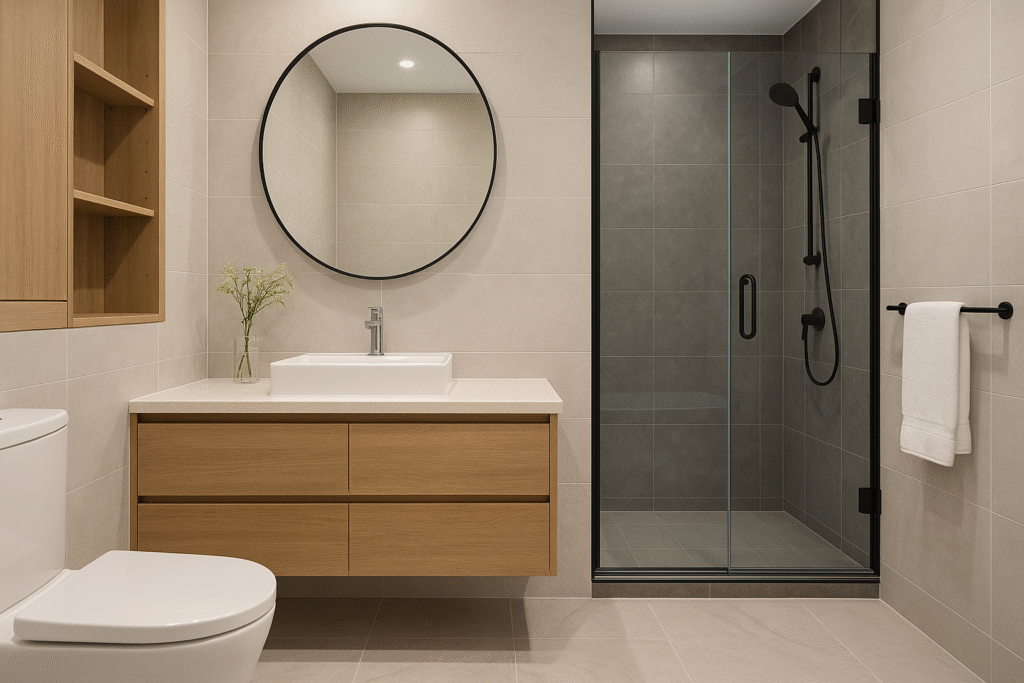
What to Do After the Remodel Is Complete
Once your bathroom remodel is finished and the last tile has been sealed, it’s time to take a step back and admire your new space but not before checking that everything is truly complete. The final phase of a remodel isn’t just about enjoying the results. It’s about confirming that every detail was delivered as promised and setting up a maintenance routine that preserves your bathroom’s beauty and function for years to come.
Start with a detailed walkthrough, preferably with your contractor present. Check that all hardware is installed correctly, drawers and cabinets open smoothly, lighting works as expected, and there are no visible flaws in the tile, paint, or grout. Turn on faucets and showers to test water pressure and temperature. Make sure all plumbing connections are tight and leak-free. If something doesn’t feel quite right, bring it up immediately. This is the best time to request fixes or adjustments before your final payment is issued.
Next, gather and organize all documents related to your remodel. That includes warranty information for fixtures and appliances, manuals for smart devices, and copies of permits and inspection records. If any products need to be registered with the manufacturer to activate warranties, take care of that right away. Saving these documents both digitally and physically ensures that if a repair is needed in the future, you’re covered.
Establishing a basic care routine will go a long way toward keeping your bathroom looking new. Use non-abrasive cleaners on surfaces to protect finishes. Wipe down countertops and mirrors regularly to prevent water spots. Periodically check caulking and grout for signs of cracking or mold. These small habits can prevent bigger problems and keep maintenance simple.
You should also keep an eye on your ventilation system. A good bathroom fan will help manage humidity, but it needs to be cleaned every few months to stay effective. If your remodel included an upgraded fan with automatic settings or humidity sensors, take time to understand how it works and adjust settings if needed.
As you settle into your new space, think about how it’s functioning in daily life. Are the storage solutions practical? Is lighting positioned where you need it most? Would you change anything now that the space is in use? These reflections are helpful not only for small adjustments but also for informing future renovation projects in other parts of the home.
A bathroom remodel is a significant investment, both financially and emotionally. By finishing strong with a careful inspection, organized documentation, and a regular maintenance routine you can protect that investment and enjoy the comfort and beauty of your updated space for years to come.
